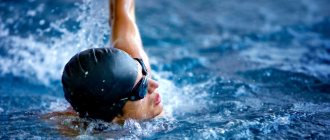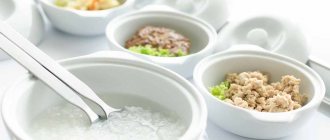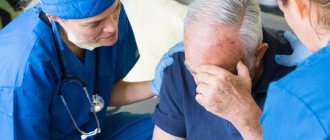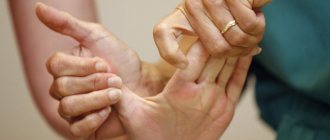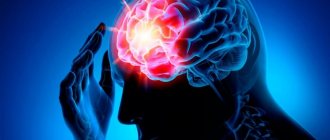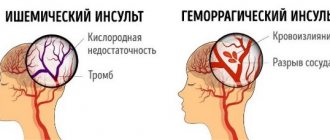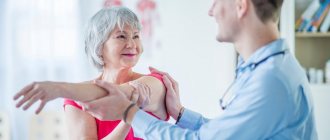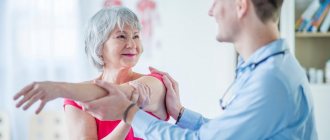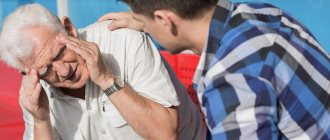Stroke is a serious brain disease characterized by circulatory disorders, focal lesions of brain tissue, and death of neurons. A stroke can be hemorrhagic or ischemic. Hemorrhagic stroke is less common than ischemic stroke and is characterized by rupture of blood vessels and hemorrhage in brain tissue. Ischemic stroke is more often diagnosed in older people and is characterized by impaired blood flow in the cerebral arteries and the death of neurons in the area of blood supply to brain tissue by the affected artery. When a stroke develops, the patient requires emergency care: the sooner the patient is admitted to the hospital, the more effective the care provided by doctors will be.
In addition to drug treatment of stroke, great importance is attached to rehabilitation therapy, which begins to be carried out in the acute period of the disease. At the Yusupov Hospital, various methods of physiotherapy and exercise therapy are used to restore patients after a heart attack and stroke. With the help of a comprehensive rehabilitation program, the patient is rehabilitated - restoration of motor activity, coordination of movements, visual function, sensitivity. The neurorehabilitation department of the hospital is equipped with modern devices, verticalizers and various simulators, including robotic ones.
The influence of exercise therapy on the patient’s nervous system
Therapeutic exercise is the performance of certain physical exercises, which begin with the simplest movements of the patient after he regains consciousness, then the physical activity gradually increases, the exercises become more complex. Exercise therapy helps improve blood circulation in organs and tissues, accelerates the process of restoration of various body functions, and improves metabolism. Physical therapy exercises for each patient are selected individually depending on the severity of the patient’s condition and concomitant diseases. An individual physical therapy program at the Yusupov Hospital is drawn up by a rehabilitation doctor.
Make an appointment
How to help yourself
Contrary to popular belief, it is strictly forbidden to independently engage in exercise therapy after a stroke at home, even if the illness experienced is characterized by the absence of negative symptoms. At the first stage, the patient in any case requires outside help - from medical workers or relatives.
At this time, loved ones need to make sure that the patient does not get hung up on negative thoughts and focuses on correctly performing exercise therapy after a stroke. In addition to physical therapy, you must remember to take prescribed medications, physiotherapy and massage in a timely manner.
Passive and active rehabilitation after stroke
The first classes with the patient are conducted by a physical therapy instructor in the ward. The patient performs simple movements with his arms and legs with the help of an instructor - this type of rehabilitation is called passive. Passive rehabilitation of the upper and lower extremities begins with the development of large joints with a gradual transition to small joints. Rehabilitation therapy begins with the shoulder and hip joints. After developing the hip joint, the instructor helps the patient flex and extend the lower limb, develops the knee, then the ankle joint, and lastly the doctor develops the joints of the foot.
The rehabilitation specialist performs massage from the foot to the thigh. During hand rehabilitation, exercises begin with the development of the shoulder joint, then flexion-extension and rotational movements of the hands are carried out in the area of the elbow and hand joints. Massage of the upper limbs is performed from the fingers to the shoulder. A set of exercises combined with massage stimulates brain function. With partial restoration of motor function, exercise therapy exercises become more complex, and the patient begins to perform the exercises independently. The time for gymnastics increases from 10 minutes to half an hour, and active rehabilitation of the patient begins.
If the brain damage is significant, the patient is paralyzed, sensitivity is lost, rehabilitation is carried out with the help of medication, massage, electromagnetic stimulation of nerve cells, acupuncture, and reflexology. After partial restoration of motor function, the rehabilitation doctor introduces therapeutic exercises into the program.
Gymnastics options for different periods of stroke
The human body is unique and has the ability to regenerate, that is, to recover. Rehabilitation after a stroke at home will not help restore brain nerve cells, but exercises will help restore a person’s motor activity, restore speech, and eliminate other consequences.
The causes of disability after such a pathology are the absence or impairment of motor abilities. More often, one side, the cardiac side, suffers. But this does not mean that the exercises should only concern the left side. If the left side of the brain is affected, then paralysis occurs on the right side and vice versa.
Gymnastics is carried out with the same load on both sides, with the connection of a regular respiratory complex. These exercises may be limited to simply inflating balloons.
Rehabilitation exercises on simulators
The Yusupov Hospital uses two types of simulators for the rehabilitation of patients after a stroke - mechanical and robotic. Mechanical exercise machines include exercise bikes, treadmills, and exercise machines for restoring balance and gait. Robotic simulators are equipped with electronic biosensors that stimulate activity by influencing the affected limbs. Robotic simulators have wide functionality; they are programmed taking into account the patient’s needs, promote the transmission of nerve impulses from the brain to the injured limb, and stimulate motor activity.
Rehabilitation exercises after a stroke are performed using multifunctional exercise equipment and sports equipment. There are different types of simulators:
- To restore motor activity, use a flexion/extension simulator, a simulator for developing the joints of the limbs, exercise tracks, and exercise bikes.
- For bedridden patients, exercise equipment in the form of a bed or bicycle is used.
- To restore balance, gait, and motor activity, a horizontal simulator is used.
- For patients who cannot yet stand, a seated exercise machine has been created to develop and strengthen the back muscles.
In what cases are exercises contraindicated?
Loads cannot always help patients who have suffered such a disease.
Physical education after a stroke is contraindicated for people with certain indicators:
- people with mental disorders after a stroke cannot perform exercises;
- when convulsions or epilepsy attacks occur;
- tuberculosis of different stages;
- oncology;
- diabetes.
Only strict adherence to the doctor’s recommendations and adherence to the instructions gives a positive result.
Hand exercises for stroke rehabilitation
Hand exercises improve motor activity and help restore lost functions. In severe cases and in the absence of early rehabilitation, hand functions are often not restored or partially restored. In some cases, rehabilitation does not help; doctors carry out bipolar stimulation - an effect on immobile joints and muscles of the body using artificially created impulses from the brain to the body. This helps restore reflexes and sensitivity, improve blood circulation in the tissues. Then the patient undergoes rehabilitation using exercise therapy and other methods.
The motor activity of the hands and the motor skills of the fingers are most difficult to restore. You can often see trembling hands in a patient after a stroke; he cannot hold a ballpoint pen in his hand, cannot write, and does not grasp objects well. Especially for such patients, they conduct classes in modeling from plasticine, with a Rubik's cube, teach them to write again, and work on a silicone simulator. Doctors use reflexology if a patient has suffered a severe stroke. This helps restore fine motor skills, improve grasping movements, flexion and extension of fingers, and joints of the hand. At the Yusupov Hospital, patients undergo rehabilitation on computerized simulators using a comprehensive recovery program, which includes massage and physical therapy exercises.
Hand exercises are not complicated and do not require special exercise equipment or devices; the patient can perform them at home:
- Lie on the bed, move your arms back and grab the headboard. Tighten the muscles of your arms and body, imitating a pull-up. Raise your legs up or stretch them straight.
- Using rotational movements of bent arms, knead the shoulder joint.
- Sit upright on the bed, place your hands behind your back as close to each other as possible, tilt your head back, then return to your previous position.
Experts insist on carrying out rehabilitation measures for three years after a stroke. As a rule, ischemic stroke gives more hope, since it is characterized by less dangerous damage to the cells of the cerebral cortex and the use of “spare” vessels for nutrition. In the hemorrhagic form, physical rehabilitation is limited to preventing recurrent circulatory disorders, timing of hematoma resorption, and the use of surgical intervention. Gymnastics after a stroke is part of planned rehabilitation measures along with medications, physiotherapy, diet, and regimen.
What problems does exercise therapy solve after a stroke?
Exercise therapy for stroke plays an important role in the prevention of complications, the development of a person’s adaptation to self-care, and the acquisition of lost functions. A long period of forced immobility in bed is dangerous for the development of severe consequences. The exercise therapy complex helps prevent:
- formation of bedsores on the buttocks, back;
- congestive pneumonia;
- the occurrence of heart failure;
- progressive atrophy of non-working muscles;
- formation of blood clots followed by embolism in vital organs;
- spasm of muscle groups with increased tone during paresis and spastic paralysis, formation of contractures (change in limb shape).
Gymnastics after a stroke has a positive effect on microcirculation and metabolism in organs and tissues that are reduced as a result of the disease. It allows you to resume active movements and, in the long term, helps you gain the ability to draw, write, and use dishes and household appliances. Leads to normalization of the functioning of internal organs (urination, defecation), helps restore speech.
When can you start exercising?
The beginning of the use of physical activity, its volume, and target orientation are determined by the attending physician depending on:
- the extent of damage to brain tissue;
- sufficient ability of the body to recover;
- timeliness and completeness of treatment.
The first 6 months are considered the acute period. At this time, changes occur in the ischemic focus: some cells die irrevocably, while others retain the ability to perform their functions, but need help. This is exactly what exercises after a stroke are designed to do. At the cellular level, there is a special memory that should “remember” the range of movements and restore the transmission pathways of nerve impulses. If the patient is not in a coma and consciousness is preserved, then on the third day he is recommended to begin breathing exercises. Its goal is to prevent congestion in the lungs. From the fifth day, physical therapy (PT) is prescribed. The sets of exercises include familiar movements, taking into account the patient’s condition, the ability to sit or stand independently, and the degree of loss of motor functions. It is recommended to continue physical education after discharge at home. To do this, loved ones should learn the necessary exercises themselves, support and encourage the patient’s aspirations. Positive emotions and good mood play a significant role in the speed of rehabilitation. In the later period (after six months or more), the patient needs to use a rehabilitation course of treatment in specialized centers and sanatoriums. It is recommended to repeat therapy 2 times a year
How to do breathing exercises?
While lying down, the patient simply needs to take a few deep breaths, repeat throughout the day as often as possible. When the doctor allows you to sit, it is important not to bend your back, but to keep it straight so that the air can straighten your lungs as much as possible. Breathing exercises involve taking a slow, deep breath, holding your breath for a few seconds, and then gradually exhaling. After each such breath, the patient needs rest. You need to make sure that dizziness does not increase, and do not strain while holding your breath.
There are options for controlling long exhalation:
- inflating a rubber ball;
- using a cocktail straw dipped into a cup of water.
This is important at any stage of rehabilitation
Proper physical rehabilitation is impossible without targeted support for mental activity. Muscle memory allows even weakened cortical structures to issue commands. The patient is recommended to accompany all exercises with mental “orders” for his legs and arms to move. This modern approach to recovery allows the patient to become a full participant in the recovery process.
What exercises can you do lying down?
If the patient is not allowed to sit and stand up or cannot do this, the exercises are carried out first in a passive mode, then in an active mode. Passive physical education means the absence of the patient’s participation, using the efforts of another person.
Exercises are limited to movements in the joints of the arms and legs. The complex gradually includes passive flexion, extension, rotation, abduction and adduction with increasing amplitude. You should not immediately try to fully complete the maximum option. Start with small vibrations up to 15 movements in each joint 3-4 times a day. It is recommended not to forget about the sequence of joint development: from the center to the periphery. In other words, exercises for the arm begin with the shoulder, then move on to the elbow joint, wrist and hand. Similarly on the legs: from the femur to the small joints of the foot.
Passive exercises in the hand with monoparesis can be performed by the patient himself with the help of a healthy hand. As a device for self-study, a loop made of fabric or wide rubber is used, into which the patient threads a stationary limb and performs movements, clinging to it. The patient performs active exercises independently. Special complexes have been developed for this purpose. They begin lying down and continue in a sitting position.
A set of active movements for the hands
You can make independent movements with your hands up to 20 times in one approach:
- clench and unclench your fingers into a fist;
- circles in both directions in the wrist joint (it is recommended to keep your fist clenched);
- flexion and extension at the elbows;
- from a position along the body, slowly rise and fall, while loading the shoulder joints;
- swing to the sides.
Exercises with dumbbells use the flexor muscles and hold by clenching the hand into a fist.
After a stroke, a person loses the ability to make small movements with his fingers. And this is very necessary in restoring self-service. To develop hand motor skills it is recommended:
- Place small items (nuts, buttons, spools of thread, pencils) in a large bowl;
- the patient should transfer them with the affected hand from one bowl to another.
In sanatoriums, games of mosaic, lotto, and collecting pyramids are used.
A set of active exercises for legs
For the legs, exercises can also be started with a period of strict bed rest and continued while sitting. The number of repetitions should not tire the patient and increase gradually to 20.
- The toes actively perform flexion and extension.
- Pull your socks towards you, then move them to the opposite extreme position (it is recommended to mentally imagine the pressure on the pedals).
- Slow knee flexion, extension.
- Abduction to the side due to the work of the hip joint.
How to develop the muscles of the torso?
Lying on your back, you can perform the following exercises 5-10 times:
- turns to the sides by rolling from one side to the other;
- with emphasis on the shoulder blades, back of the head, feet, using the elbows, lift the pelvis;
- try to slightly raise your upper body by tensing your abdominal muscles.
- An important means of restoring and improving the motor activity of patients after a stroke is hydrokinesitherapy. The aquatic environment in which classes are conducted has a general tonic effect on the body, increases muscle elasticity and joint flexibility, and improves tissue trophism. Physical exercises performed in water have a relaxing effect on spasmed muscles, restore the smoothness of movements and their coordination. The recommended water temperature in the pool for patients with stroke consequences is 29-35°C; Duration of classes – 30 minutes.
What other movements need to be developed?
Physical education after a stroke, in addition to the limbs, requires the development of facial muscles, especially the eyes. To prevent drooping of the eyelid, the following exercises are recommended 5-7 times:
- eye movements up and down and to the sides;
- describe a circle with your eyes in one direction, then in the other;
- blink and squeeze for a few seconds.
To strengthen your neck muscles you need to:
- make slow turns of the head to the sides;
- rest your head on the pillow, then relax.
Exercises while standing
For a patient who is able to stand and move slowly, the number of exercises should be increased and varied. However, there is no need to rush. You need to start with a simple complex, and then move on to a more complex one with increasing load. The following exercises are considered simple:
- stretching with a description of circular movements with the hands and mandatory control of breathing (when moving up, take a deep breath, down, exhale completely);
- alternately rolling from toes to heels with tension in the calf muscles;
- turns to the sides (5-6 times each);
- squats without lifting your heels off the floor 4–5 times;
- bending to the sides while raising the opposite arm above your head 4 times;
- swing your legs forward and to the sides, 4 each;
- alternate lunges forward with a slight shift of weight to the front leg.
Added to the complex with increased load:
- stretching with hands clasped in a “lock”;
- swinging your legs while holding your hand on a stationary headboard of a bed or chair;
- bend forward and to the sides 10 times, standing on tense legs in a position slightly wider than shoulder width;
- “boxing” with your hands while turning your body;
- circular rotations in the shoulder joints forward and backward;
- arbitrary jumps.
The exercises should be completed by walking in place and deep breathing movements for 5 minutes.
Contraindications
Limitations in rehabilitation depend on the patient's condition. Physical activity is not indicated in the following cases:
- the patient did not recover from the coma;
- mental changes in behavior and aggressiveness are observed;
- repeated stroke in an elderly person;
- there are symptoms of epileptiform seizures, cramps in the limbs;
- Stroke is accompanied by severe diabetes mellitus, tuberculosis, and cancer.
An important point in physical therapy is the patient’s comfortable state of health. The appearance of headaches and weakness requires control of blood pressure, rest, and a slower rate of increase in load. After gaining the opportunity to walk, it is necessary to use walks in the air with a gradual lengthening of the route. Confidence in one’s abilities and the support of loved ones allows the patient to take stroke therapy as beneficially as possible and strive for a full recovery.
For the shoulder joint
Restoration of the forearm and shoulder joint takes place with the help of flexion and extension exercises, rotation, push-ups, muscle tension and relaxation, clapping, and massage. To do this, use exercise machines, dumbbells, and various devices. First, the arm is kneaded, then a set of exercises is performed; therapeutic exercises are always combined with a massage of the limbs. A set of exercises for the shoulder joint:
- The patient lies on his back, arms extended along the body. The instructor holds his hand at the elbow to avoid bending, takes the patient's palm with his other hand and moves the patient's arm up and down.
- The instructor performs circular movements with the patient's arm fixed in a straightened state.
- The patient lies on his back, with his arm slightly to the side. The instructor turns the straightened arm over, palm down, then up.
For lower limbs
Exercises for the lower extremities begin to be performed as soon as the patient regains consciousness. At the initial stage, the instructor helps to bend and straighten the lower limbs; over time, the patient will be able to imitate walking in a prone position, then get out of bed, learn to maintain balance, and walk without support. Exercises for patients in the supine position:
- The patient is in a supine position, the leg is straightened. The instructor turns the leg with the foot inward, then outward.
- The patient is in a supine position, the leg is bent at the knee. Holding one hand under the knee, the instructor performs circular movements with the limb, holding and pressing with the other hand in the hip joint area.
- The patient is in a supine position, the affected leg is bent at the knee. The instructor fixes the leg at a right angle, holding it with the other hand under the knee, bends and straightens the lower limb.
- The patient is in the same position on his back, with the leg fixed at a right angle. The instructor, holding the patient's leg under the knee, moves it away from the body and returns it back.
These exercises are performed by the patient after he is allowed to sit:
- In a half-sitting position, holding the edges of the bed with both hands, stretch both legs forward as evenly as possible, bend over, throwing your head back. While stretching your limbs, take a deep breath, return to your previous position and exhale.
- Remain in the same body position, keep your breathing calm and deep, slowly lift your right leg up and lower it back, then your left leg.
- In a half-sitting position, bend your leg, pull your bent leg at the knee as close to your chest as possible (you can help with your hands), and tilt your head forward during the exercise. Bending the leg, inhale, straightening the limb, exhale, return to the previous position.
Exercise therapy to restore visual function after stroke
At the Yusupov Hospital, patients with visual impairments will be able to undergo examination, treatment, rehabilitation, and, if necessary, surgical treatment in a network of partner clinics. Rehabilitation after a stroke includes exercises that you can then do at home. Depending on the type of visual impairment, rehabilitation therapy is carried out:
- If lateral vision is impaired, intensive medical and restorative treatment is carried out, undamaged areas of the cerebral cortex take over the lost function, and vision is restored. In this case, the doctor marks with a red line a passage of text on the page of the book on the side of which lateral vision is weakened. Before starting to read, the patient must look for the red line - this will be the beginning of the text.
- With oculomotor nerve palsy, the patient cannot look straight and his eyes look in different directions. Such a disorder can resolve over time with proper and timely treatment and rehabilitation. With paresis of the oculomotor nerve, accommodation may be impaired. Over time, the patient gets used to using only central vision. To determine the impairment of perception of objects at far and near distances, the following test is performed: the doctor takes a pencil in each hand and brings one of the pencils closer to the patient’s face, then moves his hand back.
- If atrophy of the oculomotor nerve develops, the patient's function of the upper eyelid muscle is impaired. Nystagmus or trembling of the eyeballs may occur. Often this condition leads to visual impairment.
To restore vision, the doctor asks the patient to draw the other half of an object in a drawing or take part in a certain type of computer game. The patient is asked to follow with his gaze the pencil in the doctor’s hand, which moves in front of the patient’s face to the right, then to the left, up or down. The patient should follow the pencil without turning his head. To improve blood circulation, eye massage is necessary and beneficial. The eyes are closed, with gentle movements in a circle the patient massages the eyeballs, lightly pressing on them. The exercise should be performed for 10-20 seconds.
To restore visual function, a number of eye exercises are performed:
- Rotate the eye to the right, then to the left - repeat several times.
- Look up, then down - repeat the movement several times.
- Movement of the eyes in a circle - to the right, then to the left.
- Take a short break with your eyes closed, open your eyes and blink frequently for a few seconds.
- Close your eyes tightly and relax - repeat several times.
- Fix your eye on the object, then turn your head to the right and left without taking your eyes off the object - do this several times.
Types of speech disorders
Modern medicine knows two main types of speech disorders after a stroke: aphasia and dysarthria. In the first case, speech is impaired due to the death of neurons and their connections in the brain center that is responsible for speech. Aphasia can be complete or partial. Dysarthria occurs against the background of the fact that the centers in the brain responsible for the functioning of speech muscles have been damaged.
Aphasia
It is the most common cause of speech impairment. There are six variations of aphasia in total:
- Motor
. This form is divided into two more types of aphasia. With afferent aphasia, the patient cannot choose the articulatory posture that is needed in order to pronounce specific sounds. With efferent aphasia, speech is preserved at an instinctive level, but repetition is impaired. Victims have difficulty moving from one position to another. - Dynamic
. In this variant, patients experience problems with active utterance: the inability to correctly formulate a sentence because both external and internal speech are impaired. There are frequent cases of echopraxia - repetition - situations when the patient automatically begins to repeat words, phrases, facial expressions or gestures after the interlocutor. - Sensory
. It is divided into three types: cortical, subcortical and transcortical aphasia. In the first case, the patient lacks both understanding and pronunciation of sounds; in the second, the transmission of impulses from the parts of the brain responsible for the perception of sound information is distorted. In the third case, writing and visual function are impaired, but the patient is capable of perceiving light speech structures. - Sematic
. The victims do not fully understand the complex speech structures that are responsible for spatial relationships. Problems are often observed when completing tasks that contain complex syntactic formulations. Patients forget the names of the simplest household items - dishes, furniture, clothing, electrical appliances, and read slowly. Sometimes acalculia develops, a neuropsychological disease when a person loses the ability to count consistently. - Acoustic-mnestic
. With this aphasia, patients experience difficulties that are associated with the ability to retain information perceived auditorily in memory. During classes with a speech therapist, patients cannot repeat the simplest connections of several words, or understand the meaning of a sentence when it is pronounced at a fast pace or during a conversation with several interlocutors. - Total
. A distinctive feature of this type of aphasia is the complete absence of speech due to damage to a large number of areas of the brain. Total aphasia is subject to hard and long-term correction work from various specialists - from massage therapists to speech therapists.
Dysarthria
A type of speech disorder when a stroke victim has impaired functioning of the organs responsible for articulation (tongue, palate, lips). It is observed much less frequently than aphasia and develops, as a rule, with damage to various brain structures, in particular the cranial nerves involved in the work of speech muscles. Patients experience sluggish and uncertain speech, and difficulty pronouncing individual sounds or words.
Articulatory dyspraxia
Another type of speech impairment is the inability of a person to make consistent movements with the mouth, lips, and tongue - which is divided into two types: kinetic and kinesthetic.
In the first option, difficulties arise when sequentially changing sounds and syllables, skipping them, replacing one syllable or sound with another, and incorrect placement of stresses.
In the second option, disturbances occur in the articulatory structure: the brain experiences difficulty interacting with the muscles responsible for producing sounds.
The formation of motor skills is carried out through adequately coordinated actions. After a stroke, neuronal death can occur in areas of the brain with the premotor, profrontal and motor cortices, which can lead to dyspraxia.
The correction of dyspraxia is carried out by a speech therapist in collaboration with a neurologist and psychologist.
Restoring fine motor skills after stroke
Fine motor skills are restored with the help of simple exercises that allow you to restore fine hand movements and finger flexibility. The most effective activities for restoring fine motor skills are putting together puzzles, various objects from small parts of a construction set, drawing, fastening buttons on clothes, and lacing shoes. To restore the function of the hand and fingers, the patient is asked to take two nuts in his hand and roll them with the movement of the palm and fingers. Recommended for patients after a stroke to develop fine motor skills:
- Sort through the beans and peas, separating the peas from the beans.
- Use special silicone hand trainers with spikes to massage your palms and fingers.
- Tighten and unscrew nuts, close and open the lock with a key, turn on and off the lights in the room, write texts.
Recommendations from physiotherapists
After a stroke, life changes not only for the victim, but also for those close to him. You need to understand that there is a long rehabilitation ahead, which can last for several years. This is why rehabilitation exercises after a stroke are so important. Many people use methods recommended by their doctor. Recommendations from specialists in this direction will not hurt, among whom Bubnovsky’s technique receives special attention.
The main direction of rehabilitation therapy of this doctor is kinesitherapy - restoration through movement. He, like other doctors, argues that it is important to begin the method he developed immediately after severe symptoms have been relieved. Initially, this is passive therapy with the help of assistants. Later, patients begin to perform exercises themselves using exercise machines.
Restoring speech after a stroke
Speech function after a stroke is restored much worse than motor function. Its recovery can take a long time, over several years. Speech therapists at the Yusupov Hospital are developing a program and working with the patient to restore speech throughout the entire period of his stay in the hospital; after discharge from the hospital, his relatives are involved in the patient’s rehabilitation. To restore speech, the following techniques are used:
- Pronunciation of an incomplete word - the patient must complete the word independently.
- If speech function is completely lost, rehabilitation begins with the pronunciation of individual sounds.
- When the patient learns to pronounce words, he is forced to repeat short poems and sayings.
- Singing is considered one of the best methods of speech restoration.
- In order for the patient to learn to speak faster, the facial muscles and tongue muscles should be trained. For this purpose, the patient is taught to curl his lips into a tube, stick his tongue out of his mouth as far as possible, and lick his lips with his tongue, first in one direction, then in the other. Lightly bite your lower lip, then your upper lip, and bare your teeth.
Make an appointment
Signs of speech impairment
The fact that the areas of the brain responsible for speech were damaged during a stroke is indicated by the behavior of the victim:
- The patient confuses words and sounds, stumbles, stutters;
- The construction of sentences is disrupted - instead of “I went to the street,” a person can say “I went to the street,” etc.;
- Frequent repetition of the same sounds or words;
- The patient does not understand well what is being said to him, forgets the names of objects;
- Consistent counting skills are impaired;
- Obscene words and expressions appeared.
The last factor often comes as a surprise, since after a stroke even cultured and well-mannered people can begin to swear. Experts say that this is due to the ancient origin of obscene language.
Rehabilitation of the patient at home
Before the patient is discharged from the hospital, relatives receive recommendations on caring for the patient after a stroke. Recommendations for rehabilitation will be provided by the attending physician. The rehabilitation exercise program is performed every day without breaks, 2-3 times a day. Performing physical exercises should not tire the patient or cause him pain. Exercises in a sitting position help prepare the patient for walking.
When the condition improves, exercises are performed in a standing position; they help eliminate neurological disorders as much as possible by restoring fine movements. The patient performs exercises with an expander. From a standing position, he bends down and picks up a matchbox from the floor. Performs breathing exercises with raising your arms up while inhaling, standing on your toes, then lowering yourself onto your entire foot, lowering your arms, exhaling, leaning forward. A comprehensive recovery program is aimed at reducing muscle tone, improving blood circulation, preventing joint contracture, restoring and maintaining fine motor skills, speech, preventing the formation of bedsores and the development of inflammatory processes.
The Yusupov Hospital uses modern rehabilitation methods, uses various types of exercise equipment, and physical therapy exercises. Rehabilitation doctors develop an individual rehabilitation program for each patient.
General rules of care
The recovery period after a stroke is divided into early (up to 6 months), late (6-12 months) and residual effects (after 1 year). Ideally, in the early recovery period, the patient is recommended to be treated in palliative hospitals, sanatoriums, in the late recovery period and during the period of residual effects - in a day hospital, rehabilitation department, or by a visiting team at home. In reality, most often patients are at home after an acute period of stroke, and the main question that arises among their loved ones is where to begin rehabilitation. One of the main tasks of the rehabilitation process is to create comfortable conditions that promote relief and speedy recovery.
Preparing the premises
To exclude the impact of external traumatic factors (light, sound, temperature stimuli) on the patient’s psyche, he should be placed in a bright, well-ventilated room, where no extraneous noise can be heard from the street. The room should maintain a comfortable temperature within +18-22 °C.
The room should not be cluttered with furniture or objects that are easily moved out of place. A good alternative to a regular bed would be a functional one - with adjustable height and backrest position, side rails, and lockable wheels. Near the bed you need to place a bedside table with hygiene items, a blood pressure monitor, other necessary things, a wheelchair or other mobility aids (walkers, canes), a portable toilet or a bedpan.
If the person caring for the patient is not always with him, you can equip the room with a call button that the patient can easily reach, or replace it with a regular bell. Patients who can move independently or are beginning to train the skill of walking will find handrails along the walls very useful, and anti-slip mats in the bathroom will prevent injuries.
Body hygiene and bedsore prevention
Adequate prevention of bedsores can prevent their occurrence in 80% of cases.
Preventive measures:
- a special anti-bedsore or foam mattress with a thickness of at least 10 cm;
- soft bed linen without wrinkles;
- special cushions or pads made of foam rubber for vulnerable parts of the body (back of the head, shoulder blades, elbows, sacrum, heels, ankles);
- changing body position every 2-3 hours;
- comfortable underwear;
- prevention of skin trauma - carefully moving or turning over the patient.
It is important to carry out proper hygiene measures and skin care. At least once a day, during hygienic procedures, you should examine the entire surface of the patient’s body, vulnerable areas - every time you turn over. You should use waterproof diapers and diapers and change them as needed. It is necessary to wash the patient with warm water without soap after each bowel movement, washing with soap - no more than once a day, it is better to use liquid soap. After washing, the skin is thoroughly dried with a soft towel. For dry skin, moisturizing and nourishing creams are used; for diaper rash, powders without talc are used.
Nutrition
Food should be comfortable to swallow and easily digestible. The patient needs a sufficient amount of fluid - at least 1.5 liters. in the absence of restrictions. Drinking should not be limited even with urinary incontinence, since with a lack of fluid, urine becomes concentrated and irritates the skin.
The patient's diet should contain a sufficient amount of protein. It can be a soufflé, minced chicken, beef, rabbit, or fish. Patients who have difficulty chewing or swallowing semi-solid foods may be given meat or fish broth.
The menu should include dishes rich in vitamin C, iron, zinc, fermented milk products, fruits and vegetables.
Food is prepared boiled or baked and must be freshly prepared. You should not eat fried foods, pickles, smoked foods, spicy foods, canned food, fast food, carbonated and sweet drinks. You need to eat 4-5 times a day, in small portions.
